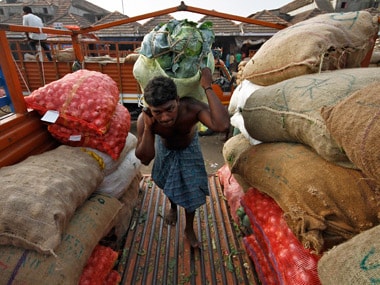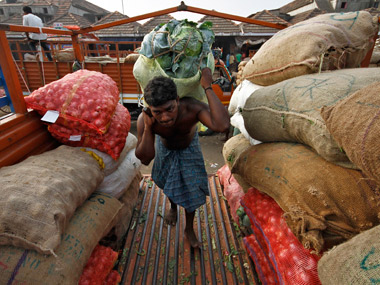Mumbai: A spike in headline inflation is an “unwanted complication” in a slowing economy and will prevent the Reserve Bank of India from cutting rates, analysts said on Monday, warning of the “spectre of stagflation” that India risks getting into. India’s retail inflation accelerated to 7.35 percent in December due to high food prices, government data showed on Monday. “A closer look shows the current spike in inflation comes from transitory or idiosyncratic factors. Let’s call them ’noise’. Does that mean the RBI can pass over the noise as just noise? No,” analysts at rating agency CRISIL said. “Along with slowing growth, more-than-desirable inflation raises the sceptre of stagflation,” they warned, a PTI report said. A ‘stagflation’ is an undesirable phenomenon that has persistently high inflation with high unemployment and stagnancy in demand. It can be noted that under the medium-term target it signed with the government, the RBI is mandated to keep the inflation at 4 percent with the flexibility to have a 2 percentage point relaxation on either side. The central bank had surprised watchers by keeping rates unchanged contrary to the expectation of a cut to boost the sagging economic growth, which slid to an over five-year low of 4.5 percent for the September quarter. [caption id=“attachment_4349397” align=“alignleft” width=“380”]  Representative image. Reuters.[/caption] Rating agency ICRA said it expects the number to correct sharply in January but the RBI’s rate-setting Monetary Policy Committee (MPC) will pause over next few of its bi-monthly review meets. Private sector lender Yes Bank’s house economists said they do not expect a cut until the last quarter of 2020. The analysts at Crisil explained that food is the noisemaker at present and if one were to exclude vegetables and pulses which have resulted in the spike, food inflation comes at 5 percent which is still at a 33-month high. The core inflation, which is price rise excluding food and fuel, also runs the risk of getting impacted because of the rise in telecom prices, it said. Care Ratings also flagged the high fiscal deficit, which induces inflation, is also a concern. It can be noted that there are calls for looking over the fiscal deficit concerns to push up the growth process ahead of the Union Budget scheduled for 1 February. December inflation was higher than 6.20 percent forecast in a Reuters poll of analysts. Experts weighed in with their comments to Reuters. Anagha Deodhar, Economist, ICICI Securities, Mumbai This number is sharply higher than our forecast. We expect inflation to continue to inch up in the coming months due to higher food prices. Also, the base is unfavourable in January 2020 as CPI had fallen to below 2 percent in January 2019. Hence, both the base effect and price momentum are likely to keep prices elevated in the near future.” I think the MPC will be very cautious at the next policy (meeting). While just one print may not be enough to change rates or stance, we expect intense debate on the inflation issue at the upcoming monetary policy.” Aditi Nayar, Principal Economist, ICRA Ltd, Gurugram CPI inflation in December 2019 overshot both our projection of 6.7 percent as well as the upper threshold of the MPC’s band of 2 percent-6 percent by a substantial margin, driven by the double-digit surge in the food inflation. The increase in the core CPI inflation was more modest than what we had feared in light of the revision in telecom tariffs. Nevertheless, the revision in rail fares, uptick in prices of some categories of automobiles, as well as an unfavourable base effect, may contribute to a further uptick in the core inflation to around 4.0 percent in the ongoing month.” Madan Sabnavis, Chief Economist, CARE Ratings, Mumbai CPI inflation at 7.4 percent is probably the highest in over five-and-a-half years, which was last recorded in July 2014. This is well above our forecast of 5.8 percent. This has been led by food inflation of 14.1 percent with one single component, vegetables, rising by 60.5 percent.” “Vegetable prices and inflation should come down in January with the new onion crop in and prices moving down. However, the low base effect will impact inflation for one more month.” Radhika Rao, Economist, DBS Bank, Singapore December headline inflation witnessed a significant jump, to a five year high, along with an uptick in core inflation (3.7 percent). Base effects added to the buoyancy, which was also driven by higher food prices - vegetables and proteins.” “Spurt in January’s number could be sharper given adverse base effects in the comparable period last year.” “Pipeline pressures exist from an upcoming increase in telecom prices, medicine costs and adjustments in cement/steel, keeping the headline in the 6percent handle in the March quarter and above target for at least four-six months thereafter.” Joseph Thomas, Head-Research, Emkay Wealth Management, Mumbai “CPI at 7.5 percent broke the ceiling going beyond the RBI tolerance limit of 6 percent, fully reflecting the recent uptrend in food prices. While fruit and vegetable prices may come down as these crops have short cultivation cycles, the rise in prices of pulses may stay on for more time.” “While RBI may not hike policy rates in the immediate future, it may not be able to cut the rates either. While the circumstances around likely fiscal slippages may have an adverse impact on interest rates, the inflation level would add to these worries in the immediate term.” Madhavi Arora, Lead Economist, FX and Rates, Edelweiss Securities, Mumbai CPI inflation surged 7.35 percent in December, sharply overshooting the RBI’s 2 percent-6 percent policy target for the first time since mid-2016. Overall, this would constrain the RBI’s hand in conventional easing even as the output gap remains negative. We think monetary accommodation still has further steam of another 50 bps in this rate cut cycle, albeit the timing of same is a tad tricky. The upcoming budget in February would be closely watched for a fiscal stance which could impact RBI’s reaction function. Even so, our estimates suggest inflation will likely remain above 6.5 percent in 4QFY20 and could constrain a rate cut in February.” A Prasanna, Economist, ICICI Securities Primary Dealership, Mumbai I don’t expect a change in policy in February, but beyond that we still retain our view of a residual 15-25 basis points rate cut. However, April might be too soon for a rate cut due to headline inflation overshooting RBI’s estimates by more than 200 bps. Further beyond April, growth recovery may also take a firm footing, so there is a good likelihood that the rate cut cycle is over even if inflation subsides to around 4.5 percent by H2FY21. Still the caveat to this view is that we need to monitor how quickly the vegetable price rise draws down. For tomorrow we could see bond yields rising by around 5 basis points, assuming there is no open market operation announced today.” Rupa Rege-Nitsure, Group Chief Economist, L&T Financial Holdings, Mumbai A sequential jump of 181 bps in headline CPI inflation to 7.35 percent in December is worrisome, even though it’s primarily led by supply shocks. Core inflation too has gone up by 25 bps to 3.76 percent. In hindsight, this vindicates RBI’s pause in the rate-cutting cycle in December. I expect January print also to be uglier as a statistical base will continue to stay unfavourable. Given the weakness in demand, RBI will continue to keep the stance at accommodative, as inflation is likely to cool from February onwards. I don’t expect expansionary fiscal policy to contribute to inflation, given the intensity of slowdown. The current stagflationary phase is due to supply shocks in the food and fuel sectors and adverse base effect. Sreejith Balasubramanian, Economist, IDFC AMC, Mumbai The headline CPI number of 7.35 percent y/y in December 2019 was slightly above our expectation in the vicinity of 7 percent, owing to higher inflation in food, transport and communication. We believe the RBI could pause in its upcoming February meeting given supply-side food inflation is likely to keep the January CPI print above its target, despite onion prices already having started to fall. Fiscal plans envisaged in the budget would also be looked at. Sakshi Gupta, Senior Economist, HDFC Bank, Gurugram The sharp jump in CPI has been driven by not just higher vegetable prices, but also some pickup in protein inflation. We expect inflation to remain above 6 percent in January and remain elevated between 5.5-6 percent over the next 1-2 months thereafter. Higher food inflation, revisions in LPG price, increase in telecom tariffs, and an unfavourable base effect is likely to keep the pressure on inflation at least till March-end. Given the spike in the inflation rate, we expect the RBI to remain on hold at its February meeting. Shubhada Rao, Chief Economist, YES Bank, Mumbai CPI at 7.35 percent is at a 5-year high led predominantly by food, fuel and miscellaneous. Given this number, over the next few months, CPI is expected to firm up further. For the headline to converge to 4 percent over the next fiscal year, food inflation will need to reverse dramatically. We maintain our no rate cut until October-December quarter in 2020. Upasna Bhardwaj, Senior Economist, Kotak Mahindra Bank, Mumbai We expect the headline inflation to sustain above the upper tolerance level over the next few months before gradually tapering, as fresh food supply begins to hit the market. Clearly the room for monetary easing in the first half of calendar 2020 remains minimal despite growth continuing to remain below potential.” Prithviraj Srinivas, Chief Economist, Axis Capital, Mumbai At current trends, CPI inflation would average above 6.5 percent from December to March. This is significantly above our previous expectation since food inflation remains unchecked despite imports and availability of stocks. In hindsight, the RBI has been ahead of the market by pausing in the previous meeting versus market consensus of 25 bp cut. However, current trends in inflation are significantly above even RBIs projection of 5.1 to 4.8 percent in H2 FY20. Given that the inflation spike is mostly due to supply disruption and bank credit growth remains anaemic, the RBI is likely to retain its accommodative stance and leave repo rates unchanged. --With inputs from agencies
India’s retail inflation accelerated to 7.35 percent in December due to high food prices, government data showed on Monday
Advertisement
End of Article


)
)
)
)
)
)
)
)
)



